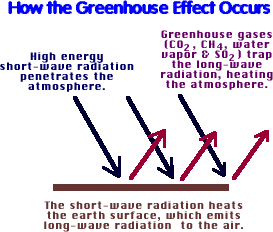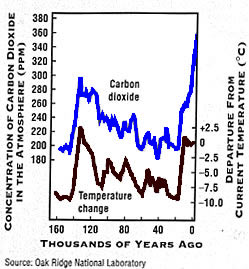

Greenhouse Effect: An increase in atmospheric temperature caused by increasing amounts of CO2 and other gases (CH4) that absorb and trap heat radiation, which normally escapes from Earth. Be aware that the greenhouse effect, and thus the corresponding global warming are both natural processes. In addition, we do want some greenhouse gases in the atmosphere, as they are what keep the earth warm enough to support life on this planet. Without the greenhouse effect, the earth would be much cooler and perhaps limited to microscopic bacteria and blue-green algae. The danger of too high a concentration of greenhouse gases in the atmosphere would be that temperatures would rise to the point that many life forms may not be able to survive!
Online Animations:

Carbon Dioxide:
a. Exhaust from cars
b. Combustion of coal & petroleum (at power plants & factories)
c. Forest fires (clearing of tropical forests for farms).
Nitrous Oxides
a. car exhaust
Methane:
a. Gases emitted by cattle
a. Global warming of the Earth by up to 3.75 degrees Celsius over the next 50 years.
b. Melting of glaciers and polar ice caps.
c. Rising sea levels (due to thermal expansion of water).
d. Flooding of lowlands.
e. More frequent storms and hurricanes.
f. Changes in weather patterns, with some regions warming & others cooling.
a. Reforestation of ecosystems. Photosynthesis decreases atmospheric CO2.
b. Spread nutrients such as iron in the sea to encourage algal growth.
c. Reduce energy consumption (especially of those energy sources that release greenhouse gases).
d. Convert from use of fossil fuels to solar, wind or nuclear power.
a) Thawing of arctic permafrost & increased decomposition of dead organisms previously frozen in the permafrost. This increased decay may "pump" more CO2 and CH4 into the atmosphere, compounding the effects of global warming.
b) Thawing of arctic ice caps. If the arctic sea loses its cover of ice, sunlight will be absorbed by the sea, raising the arctic sea temps and affecting global currents and climates. At the moment, ice over the Arctic Sea and Greenland reflect sunlight back into space, keeping the arctic cooler.
c) Loss of arctic and glacial ice would increase worldwide sea levels.
d) Organisms such as seals, walruses and polar bears would need to travel farther to find food (normally found under arctic ice). They would also have fewer places to rest so might be in danger of drowning as well as starvation.
e) Disruption to entire food chains. There is greater diversity of organisms in and near arctic sea ice. Loss of the sea ice decreases the producers and herbivores (both largely microscopic plankton) and thus effects organisms at higher trophic levels.
f) Increased sea and land temperatures increases the chance alien species and diseases may move into arctic regions.
The precautionary principle holds that, if the effects of a human-induced change would be very large or catastrophic, those responsible for the change must prove that it will not do harm before proceeding. This contrasts with the long held notion that it is the responsibility of those who hypothesize that human actions may cause great harm to humans to "prove" or find strong evidence that supports the hypothesis that this harm would occur.
Following the premise of this precautionary principle would mean that those foes of the theory of global warming would need to weigh not only the short-range economic impacts (expenses needed now to curtail the effects of global warming.......reducing warming-inducing gas pollution and conversion to more green energy friendly technologies) against the damages that might occur over the next century or two, including changes to sea levels, health, agriculture and the economic consequences that result from those changes.
a) Draw & label a diagram of the carbon cycle to show the processes involved. (Processes involved include: photosynthesis, cell respiration, fossilization, combustion.)
b) Analyze changes in atmospheric carbon dioxide concentration using historical records. (Mauna Loa, Hawaii or Cape Grim, Tasmania).
c) Explain relationships between the rise in concentrations of atmospheric carbon dioxide, methane and nitrogen oxides and the enhanced greenhouse effect.
d) Outline the precautionary principle.
e) Evaluate the precautionary principle as a justification for strong action in response to threats posed by the enhanced greenhouse effect.
f) Outline consequences of a global temperature rise on arctic ecosystems.